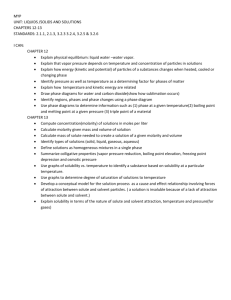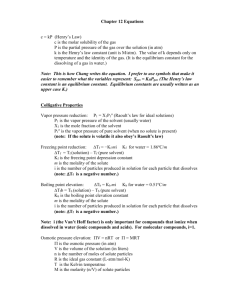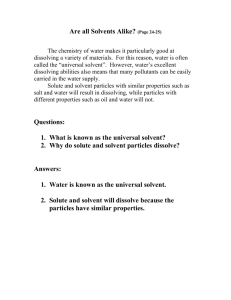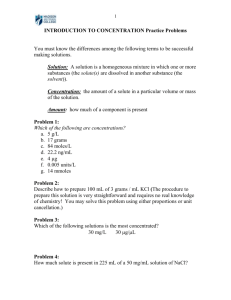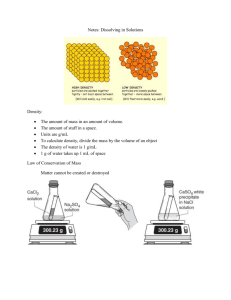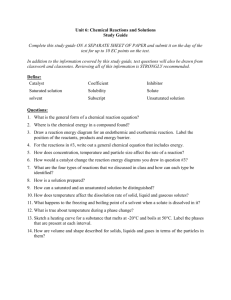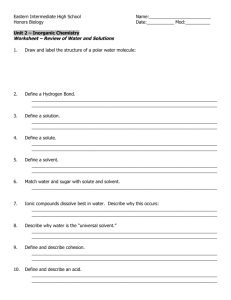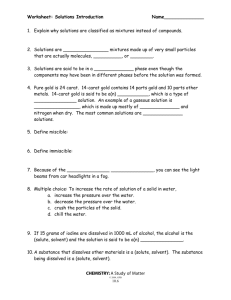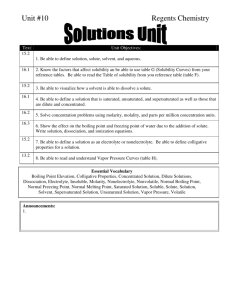Andrew Rosen 13.1 – The Solution Process Interactions between
advertisement
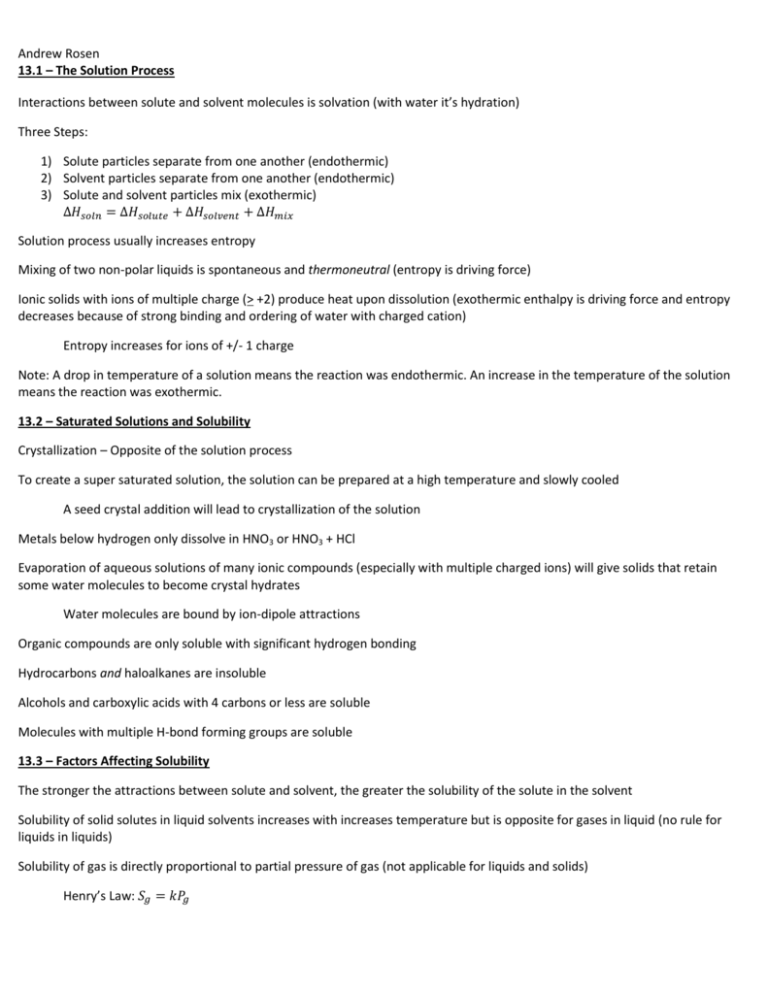
Andrew Rosen 13.1 – The Solution Process Interactions between solute and solvent molecules is solvation (with water it’s hydration) Three Steps: 1) Solute particles separate from one another (endothermic) 2) Solvent particles separate from one another (endothermic) 3) Solute and solvent particles mix (exothermic) Solution process usually increases entropy Mixing of two non-polar liquids is spontaneous and thermoneutral (entropy is driving force) Ionic solids with ions of multiple charge (> +2) produce heat upon dissolution (exothermic enthalpy is driving force and entropy decreases because of strong binding and ordering of water with charged cation) Entropy increases for ions of +/- 1 charge Note: A drop in temperature of a solution means the reaction was endothermic. An increase in the temperature of the solution means the reaction was exothermic. 13.2 – Saturated Solutions and Solubility Crystallization – Opposite of the solution process To create a super saturated solution, the solution can be prepared at a high temperature and slowly cooled A seed crystal addition will lead to crystallization of the solution Metals below hydrogen only dissolve in HNO3 or HNO3 + HCl Evaporation of aqueous solutions of many ionic compounds (especially with multiple charged ions) will give solids that retain some water molecules to become crystal hydrates Water molecules are bound by ion-dipole attractions Organic compounds are only soluble with significant hydrogen bonding Hydrocarbons and haloalkanes are insoluble Alcohols and carboxylic acids with 4 carbons or less are soluble Molecules with multiple H-bond forming groups are soluble 13.3 – Factors Affecting Solubility The stronger the attractions between solute and solvent, the greater the solubility of the solute in the solvent Solubility of solid solutes in liquid solvents increases with increases temperature but is opposite for gases in liquid (no rule for liquids in liquids) Solubility of gas is directly proportional to partial pressure of gas (not applicable for liquids and solids) Henry’s Law: Andrew Rosen 13.4 – Expressing Solution Concentration Mass% = Ppm = Ppb = Mole Fraction = Molarity = Molarity can change with temperature due to volume Make sure it is liters of solution Molality = Molality is dependent of temperature If a crystal hydrate is dissolved in water, note that the water from the hydrate also becomes part of the solvent Normality = (Essentially, the number of reactive, dissociated species times the molarity) 13.5 – Colligative Properties Colligative Properties – Depends on the number of particles present not on the identity If a non-volatile solute is dissolved in a volatile solvent, the vapor pressure of the solvent decreases, and there is a lower [] of solvent in both the liquid and gas Raoult’s Law: NOTE: To get the correct mole fraction, analyze the solute! If it’s an electrolyte, make sure to always use the moles of TOTAL NUMBER OF MOLES OF PARTICLES IN SOLUTION The mole fraction of the vapor is equivalent to the partial pressure of the vapor: ( ) Since vapor pressure of solvent is less with solute particles added and vapor pressure needs to equal atmospheric pressure, there is a boiling point elevation because more temperature is needed There is a freezing point depression for solutions with solute particles because freezing always forms pure solid solvent, so it requires more “frost” to freeze 95% pure water, for instance, than 100% pure water Since melting point and freezing point are the same, adding solute will make something easier to melt as long as it’s soluble and where molality is for all particles of solute and is subtracted (constants are only for solvent) Because electrolytes dissociate into ions, NaCl (for instance) shows about twice the is added to the normal point than a non electrolyte Andrew Rosen Ion Pairs – When dissociated ions, for a period of time, group together to form a pair Makes dissociation considered incomplete, especially at high concentrations (dissociation is less likely in high concentrations of the electrolyte and more likely in dilute solutions) Van’t Hoff Factor (i) – Average number of particles produced in solution from 1 mol of an electrolyte Can be anywhere between 1 to the total number of ions in the formula unit Osmotic Pressure – Pressure required to stop osmosis ( in the column equals , osmotic pressure) Deviates from ideal solution (ideal Raoult solution) when the solute-solvent interactions are exceptionally strong (lower vapor pressure than expected) At higher concentrations the vant hoff factor is lower because there is more ion pairing Chapter 13.6 – Colloids Common (true) solutions have solute particles that are small, so there is minimal light scattering Colloids solutions have larger particles made of small insoluble substances and disperse light for a milky appearance Different response to light is the Tyndall effect Air contains enough dust to display Tyndall effect, want the violet end of the spectrum has more color scattering than red Particles in stable colloid solutions must not cling to each other, so more ions of the same or similar charge on the surface prevent this For the colloid to be useful, it needs to be aqueous and thus polar and hydrophilic Hydrophobic colloids are made of nonpolar organic substances or metallic nanoparticles Metallic nanoparticles can be stabilized due to adherence to the surface of ions Surfactant = Amphiphilic Molecule (both-loving) Can stabilize nonpolar oil in water due to the tail and head of the stearate ion This is how bar soap works (sodium stearate) Heating a colloidal solution can lead to coagulation or adding an electrolyte since it will neutralize the surface charges
